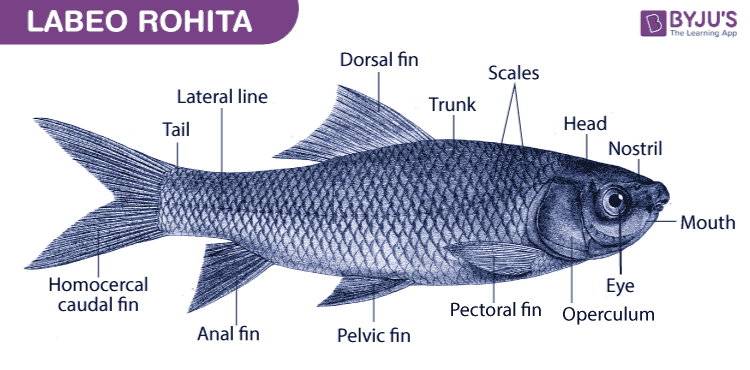Labeo rohita or rohu fish is a carp that is mostly found in rivers and ponds. Rohu is a column feeder, and due to the way it feeds, it is often cultivated along with two other carps – Cirrhina mrigala (bottom feeder) and Catla catla (surface feeder).
Let’s learn more about the habitat and description of Rohu or Labeo rohita.
Table of Contents:
- Labeo rohita – Classification
- Labelled Diagram of Labeo rohita
- Habitat
- Description
- Frequently Asked Questions
Labeo rohita – Classification
|
Kingdom |
Animalia |
|
Phylum |
Chordata |
|
Subphylum |
Vertebrata |
|
Class |
Osteichthyes |
|
Subclass |
Actinopterygii |
|
Family |
Cyprinidae |
|
Genus |
Labeo |
|
Species |
rohita |
Labelled Diagram of Labeo rohita

Habitat
Rohu or Labeo rohita is a freshwater fish mostly found in rivers and ponds. They are geographically distributed along temperate and tropical regions like Vietnam, Pakistan, Nepal, India, Myanmar and Bangladesh. Labeo breeds mostly in bund types of tanks and rivers but not in confined waters.
Description
- The adult Labeo fish is about 0.5 to 2 metres in length and weigh around 4 kg (maximum up to 45 kg).
- Their body is brownish or bluish on the dorsal surface and silvery-white below. Also, the body surface is covered with large and overlapping cycloid scales that are of taxonomic importance. These cycloid scales are round, bony and flat. The scales overlying the lateral line are perforated by the tubes of the lateral line system.
- They have a compressed and fusiform body that can be distinguished into the head, trunk and tail.
- They have a depressed head which forms an obtuse, short, and blunt snout. It also has paired eyes and paired nostrils. The head bears a fringe-lipped mouth in the subterminal region. The mouth is bounded by fleshy lower and upper lips. Two slender and filamentous barbels arise from the upper lip.
- Rohu contains homocercal caudal, dorsal, anal, ventral fins and paired pectoral fins. Their fin rays are typically soft. Furthermore, their caudal fins fork into two equal lobes.
- They have four pairs of gill slits that are covered by the operculum. The large operculum encloses gills as well as the branchial chamber.
- Weberian apparatus is present between the inner ear and swim bladder. They have mesonephric kidneys.
Frequently Asked Questions
Is Labeo rohita edible?
Labeo rohita has a great food value as its flesh is rich in proteins and minerals. It is commonly consumed as food in India, Bangladesh, Nepal and Pakistan.
What is carp?
Carps include a variety of freshwater oily fishes from the family Cyprinidae. They are mostly consumed as food. Examples – Grass carp, Silver carp, Common carp, etc.
Also Check:
Keep exploring BYJU’S Biology for more exciting topics.

Comments